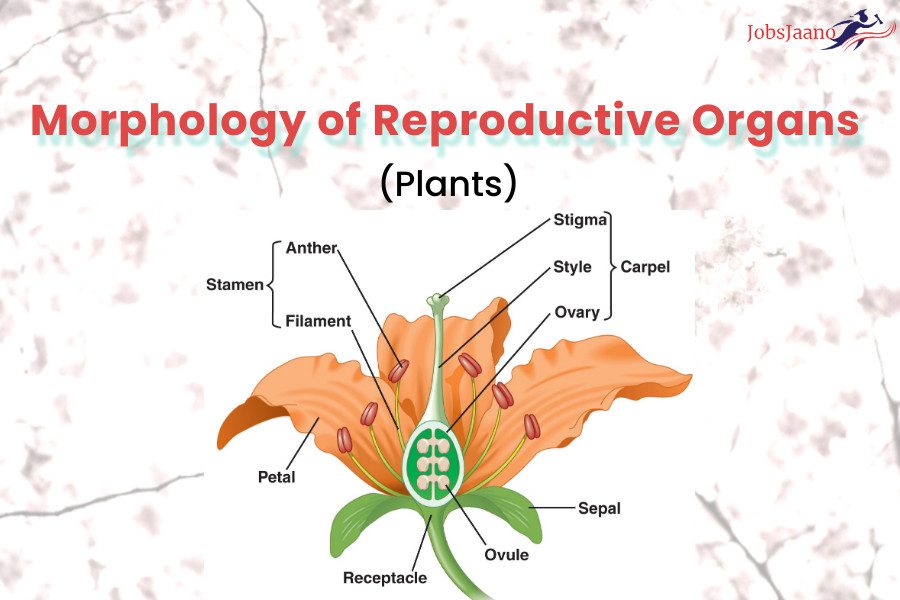Multiple choice Questions of Botany Topic Morphology of Flowering Plants MCQs with Answers ( Morphology of Flowering Plants Quiz ) for NEET, GATE, AIAPGET, NEET MDS, NEET PG, DNB PDCET, AIIMS SS, PGIMER (Other), AIIMS PG and many more competitive examinations.
MCQ on Reproduction in Flowering Plants | Morphology Questions and Answers pdf
1. Arrangement of flowers on the floral axis is
(a) inflorescence
(b) phyllotaxy
(c) placentation
(d) corymb
Ans. a
2. The whorl of bracts present below the inflorescence of sunflower is
(a) epicalyx
(b) spathe
(c) involucel
(d) involucre
Ans. d
3. Both hypanthodium and cyathium possess
(a) unisexual flowers
(b) bisexual sessile flowers
(c) bisexual pedicellate flowers
(d) sterile peduncle
Ans. c
4. In a racemose, the flower arrangement is
(a) basipetal
(b) centripetal
(c) centrifugal
(d) acropetal
Ans. d
5. Inflorescence consisting of unisexual sessile flowers, is
(a) spike
(b) spikelet
(c) catkin
(d) umbel
Ans. c
6. Name the inflorescence, in which flowers reach the same level through which they arise from different points.
(a) Umbel
(b) Catkin
(c) Corymb
(d) Capitulum
Ans. c
morphology of flowering plants mcq for neet pdf download
7. Opening of flowers in a cymose inflorescence is
(a) centrifugal
(b) acropetal
(c) centripetal
(d) basipetal
Ans. d
8. In mulberry, the inflorescence is
(a) catkin
(b) capitulum
(c) spadix
(d) cyathium
Ans. a
9. When the five sepals are arranged in such a way that two are completely external and other two are completely internal, while one is partially external, then the mode of arrangement of sepals on the thalamus is
(a) valvate
(b) quincuncial
(c) twisted
(d) imbricate
Ans. b
10. The aestivation of corolla in pea (Pisum sativum) is
(a) quincuncial
(b) vexillary
(c) ascending imbricate
(d) descending imbricate
Ans. b
11. The condition, in which stamens are united throughout their whole length is
(a) synandrous
(b) syngenesious
(c) polyandrous
(d) adelphous
Ans. b
12. Epipetalous is the condition of
(a) adhesion of stamens with corolla
(b) cohesion of stamens with calyx
(c) aestivation of petals
(d) position of sepals with respect to petals
Ans. a
13. An additional floral, whorl is present in Hibiscus roso sinensis called
(a) involucre
(b) spathy
(c) epicalyx
(d) calyx
Ans. c
reproduction in flowering plants mcq pdf neet
14. A flower is said to be zygomorphic, if
(a) any vertical section passing through its centre divides it into two equal vertical halves
(b) only one vertical section divides it into two equal vertical halves
(c) cannot be divided into two equal vertical halves by any vertical section
(d) only one vertical section passing through its centre divides it into two equals vertical halves
Ans. b
15. Which one of the following is a false fruits?
(a) Cashewnut
(b) Banana
(c) Apple
(d) Tomato
Ans. c
16. Pepo is a fruit of
(a) Cruciferae
(b) Leguminosae
(c) Cucurbitaceae
(d) Liliaceae
Ans. c
17. Marginal placentation is found in
(a) Pisum and Lathyrus
(b) Citrus and Solanum
(c) Triticum and Ranunculus
(d) Zea mays and Nymphaea
Ans. a
18. Apocarpous gynoecium is found in
(a) Ranunculaceae
(b) Malvaceae
(c) Solanaceae
(d) Liliaceae
Ans. a
sexual reproduction in flowering plants mcq | mcq on sexual reproduction in flowering plants
19. The edible part in litchi is
(a) pericarp
(b) aril
(c) mesocarp
(d) None of these
Ans. b
20. Perianth is
(a) outer part of flower in which calyx and corolla are not always distinguishable
(b) when stamens and gynoecium are not distinguishable
(c) when only calyx is present
(d) None of the above
Ans. a
21. A fruit that develops from a complete condensed inflorescence, is called
(a) schizocarpic
(b) composite
(c) aggregate
(d) etaerio
Ans. b
22. From of the following contains all others structures given in gynoecium except
(a) ovary
(b) stigma
(c) carpel
(d) filament
Ans. d
reproduction in flowering plants mcq pdf neet download
23. A pome fruit is said to be false because
(a) the pericarp is in conspicuous
(b) the endocarp is cartilaginous
(c) the fruit is present in fleshy of edible thalamus
(d) the fruit is derived from inferior ovary
Ans. c
24. An inflorescence always forms a
(a) multiple or composite fruit
(b) simple fruit
(d) aggregate fruit
Ans. c
25. The correct match for edible part of fruit is
(a) Guava – Pericarp with placenta
(b) Maize – Cotyledon
(c) Tomato – Thalamus
(d) Date palm – Epicarp
Ans. a
morphology of flowering plants neet questions pdf download
26. Which one of the following is the wrong pair
(a) Raceme – Mustard
(b) Spice – Achyranthus
(c) Compound umbel – Onion
(d) Spadix – Musa
Ans. c
27. Drupe has
(a) hard epicarp
(b) hard endocarp
(d) no epicarp
(d) hard mesocarp
Ans. b
28. Seed is a
(a) fertilised ovary
(b) fertilised embryo
(c) fertilised fruit
(d) fertilised ovule
Ans. d
29. How many plants in the list given below have composite fruits that develops from an inflorescence walnut, poppy, radish, pineapple, apple, tomato, mulberry?
(a) 5
(b) 2
(c) 3
(d) 4
Ans. b
For More Topic Wise Botany MCQs CLICK HERE
For Zoology MCQs CLICK HERE
For Environment and Ecology MCQs Click Here

